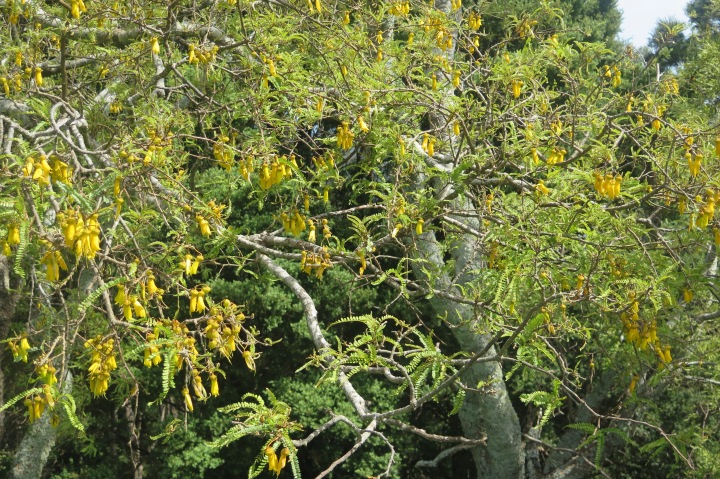Culture & History
The typical native flower is pale, white and inconspicuous. Little wonder then, that the flashy yellow blooms of the Kōwhai have become ingrained in the New Zealand consciousness. They hold unofficial status as our national flower, are a common icon of artwork and nationhood, and depictions of Kōwhai have been used on postage stamps and coins. Kōwhai is the Māori word for yellow, and describes a range of endemic species from the Sophora genus – all with strikingly bright, golden flowers.
Many Kōwhai are semi-deciduous – another uncommon feature amongst natives. The eruption of sunny yellow flowers from its barren branches was used by Māori to mark the last frost of the season; signalling the time to plant kumara. The Te Arawa tribes have a legend that the blossoming from the seemingly lifeless tree was the handiwork of a magic man, who performed the fantastic feat in order to convince a girl to marry him.
Kōwhai is most probably a fairly recent arrival on New Zealand shores (geologically-speaking that is, sometime in the last 2 – 5 million years). They come from a family of plants that have hardy buoyant seed-pods that resist salt water, which have allowed them to colonise a range of islands across the south pacific. This distribution fascinated Charles Darwin, who performed experiments with their seeds to test his theories about plant dispersal. Many places where it occurs are likely the result of deliberate plantings by Māori, and Kōwhai is often common around old pa sites and sacred areas. Its occurrence in Wellington is most probably the result of an invasion by Waikato and Taranaki tribes who used the plant for a variety of spiritual and medicinal purposes.

The trees are also planted widely in parks and gardens, not just because of their appeal to people but because they provide abundant nectar for birds such as Tui, Bellbird, and Kākā. Tui in particularly are very attracted to kōwhai and will fly great distances in search of it. In times of scarcity, Kererū will eat its leaves and flowers. Maori would avoid eating kererū that lived off kōwhai leaves as their flesh had an unpleasant smell.
Uses
Kōwhai was an important medicinal tree for many Māori tribes. Infusions made with the bark were used to treat diseased skin, scabies, dandruff, gonorrhea and various aches and pains. This infusion was a commonly used remedy for those bitten by seals, and it was said that it could heal bites in a matter of days. It was also commonly used to dress wounds, cuts, bruises, sprains, broken bones, swellings and rashes.
In 1925 the famous All Black George Nepia burst a blood vessel in his leg whilst playing rugby, and opted for a Kōwhai remedy over surgery. It apparently worked for him, and he was back playing rugby the following week. Despite its medicinal uses however, no part of Kōwhai should be consumed as it contains the toxin Cytisine. There are reports of people becoming very ill simply from eating with cutlery made from kōwhai wood.
The timber was an important resource for both Māori and Europeans, as it is tough, dense and durable. It has been used for tools, machinery, wood-splitting wedges, houses, cabinets, and fencing. The branches are also quite flexible and this made them valuable for use as bird snares. The spectacular flowers were used to produce a pigment for yellow dye.






This is awesome. Please write on Manuka and Kanuka!
LikeLike
Thanks very much!
That’s a good idea, I’ll cover it in the next post – thanks for reading.
LikeLike
WHAT IS THE NAME FOR THE KOWHAI TREE IN ENGLISH
LikeLike
Hi Mihi,
Kōwhai is the common name for the tree in both Māori and English. The word Kōwhai also means Yellow in english.
LikeLike
There is no English name for kowhai – that is what it is called by any New Zealander.
LikeLike